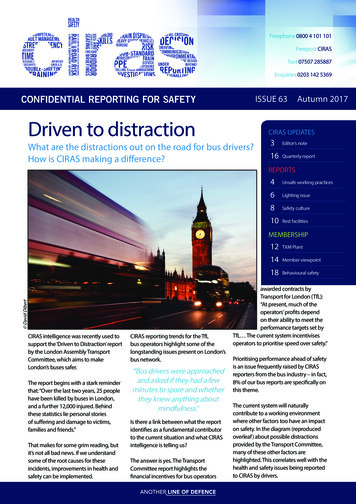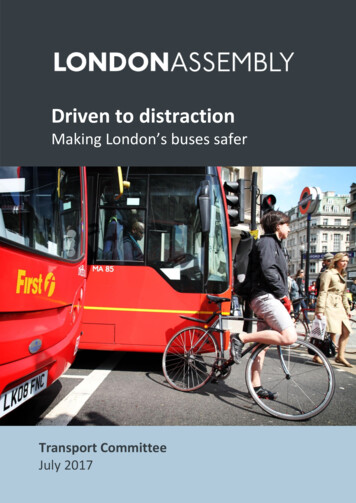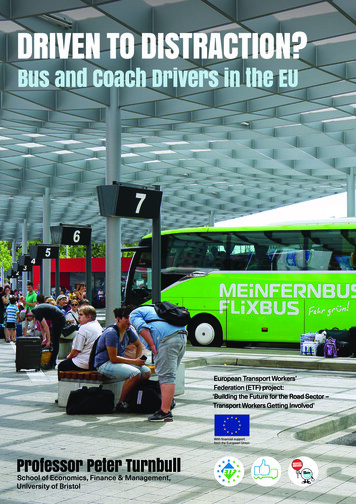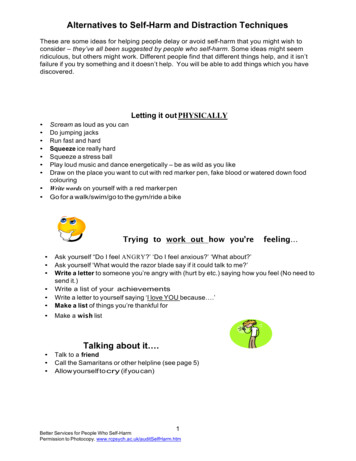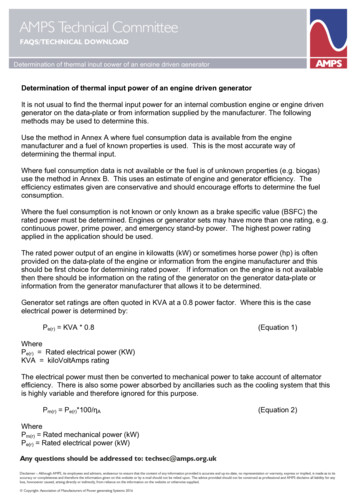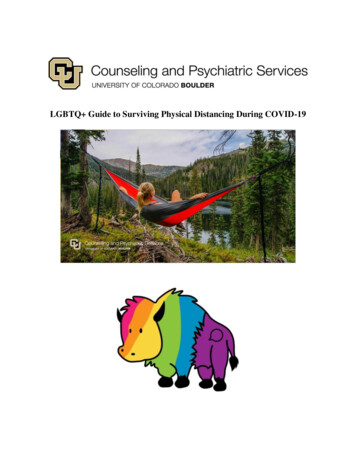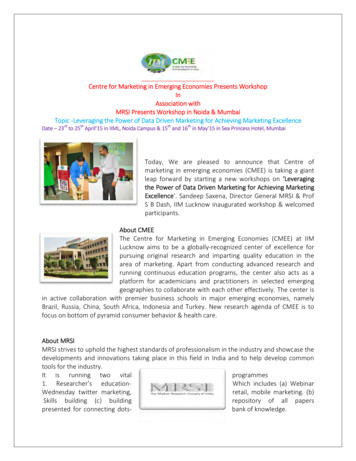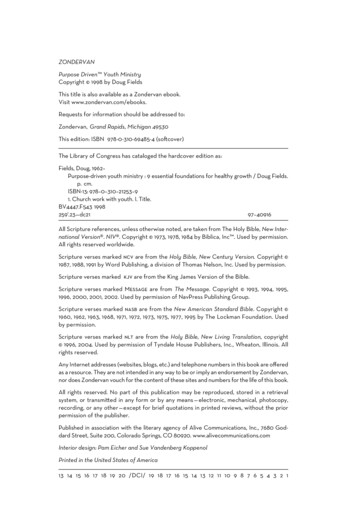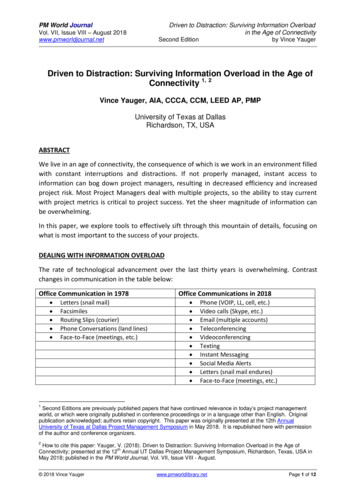
Transcription
PM World JournalDriven to Distraction: Surviving Information Overloadin the Age of ConnectivityVol. VII, Issue VIII – August 2018www.pmworldjournal.netSecond Editionby Vince YaugerDriven to Distraction: Surviving Information Overload in the Age ofConnectivity 1, 2Vince Yauger, AIA, CCCA, CCM, LEED AP, PMPUniversity of Texas at DallasRichardson, TX, USAABSTRACTWe live in an age of connectivity, the consequence of which is we work in an environment filledwith constant interruptions and distractions. If not properly managed, instant access toinformation can bog down project managers, resulting in decreased efficiency and increasedproject risk. Most Project Managers deal with multiple projects, so the ability to stay currentwith project metrics is critical to project success. Yet the sheer magnitude of information canbe overwhelming.In this paper, we explore tools to effectively sift through this mountain of details, focusing onwhat is most important to the success of your projects.DEALING WITH INFORMATION OVERLOADThe rate of technological advancement over the last thirty years is overwhelming. Contrastchanges in communication in the table below:Office Communication in 1978 Letters (snail mail)FacsimilesRouting Slips (courier)Phone Conversations (land lines)Face-to-Face (meetings, etc.)Office Communications in 2018 Phone (VOIP, LL, cell, etc.)Video calls (Skype, etc.)Email (multiple nstant MessagingSocial Media AlertsLetters (snail mail endures)Face-to-Face (meetings, etc.)1Second Editions are previously published papers that have continued relevance in today’s project managementworld, or which were originally published in conference proceedings or in a language other than English. Originalpublication acknowledged; authors retain copyright. This paper was originally presented at the 12th AnnualUniversity of Texas at Dallas Project Management Symposium in May 2018. It is republished here with permissionof the author and conference organizers.2How to cite this paper: Yauger, V. (2018). Driven to Distraction: Surviving Information Overload in the Age ofthConnectivity; presented at the 12 Annual UT Dallas Project Management Symposium, Richardson, Texas, USA inMay 2018; published in the PM World Journal, Vol. VII, Issue VIII - August. 2018 Vince Yaugerwww.pmworldlibrary.netPage 1 of 12
PM World JournalVol. VII, Issue VIII – August 2018www.pmworldjournal.netDriven to Distraction: Surviving Information Overloadin the Age of ConnectivitySecond Editionby Vince YaugerWhile the benefits of modern technology are unquestionable, an unintended consequence ofinstant access to all this data is “information overload.” This proliferation of helpful technologyprovides helpful tools that can quickly become demanding taskmasters.Ask yourself these questions: Do you feel like you’re always on call?Do constant interruptions disrupt your work flow?Do you check work email even when not at work?What does “time off” mean to you?Do you ever think “if I don’t do it, it won’t get done?”Is your phone a time-saving or time-wasting device?Modern meetings often include both computer and cell phone usage. How effective do youthink the communication is in meetings where everyone is distracted by their cell phones? Isanyone really paying attention? If not, what is the point of meeting in the first place?Ever had someone in a meeting answer their cell phone, then say “I can’t talk now – I’m in ameeting?” Are you taking full advantage of the capabilities of your smart phone? Like, say,voicemail? If it’s critical that you take the call, you could step outside before answering thephone. While response by Text is a more discreet way to deal with inability to answer calls, itstill involves you being distracted in meetings.Information overload can be further complicated by ineffective or political management. Manyemployees currently in management roles (leadership) advanced up from the PM ranks. Theymay have great technical skills but lack leadership training and experience. How many PM’stypically receive HR and employee management training? Technical skills alone may notprepare you for leadership.SOME INCONVENIENT TRUTHS The fate of the free world does not depend upon you being immediately accessible byphone or email at all timesYou work with flawed human beings – you are also one of themEvery team is dysfunctional – some are just better at it than othersTechnology is here to stay – your sanity hangs on your ability to manage informationefficientlyOPTIONS FOR MANAGING INFORMATION OVERLOADWhat can you do to cope with the deluge of information? Well, you could work harder, put inlonger work hours, learn to multitask, avoid technology, avoid meetings, ban the use of cellphones in meetings, go completely off the grid (become a “Prepper”), or return to proven “oldschool” methods (i.e. – everything on paper). 2018 Vince Yaugerwww.pmworldlibrary.netPage 2 of 12
PM World JournalVol. VII, Issue VIII – August 2018www.pmworldjournal.netDriven to Distraction: Surviving Information Overloadin the Age of ConnectivitySecond Editionby Vince YaugerIs working harder (or longer) really helping? Sometimes more is better, sometimes it isn’t. Ofcourse, if you want it done right, you must do it yourself! After all, you are a Renaissance Man– you are good at everything! And you can multitask too!So, is multitasking effective? According to Douglas Merrill in a Forbes article dated August 17,2012 “Unfortunately, our brains just aren't equipped for multitasking tasks that do requirebrainpower. Our short-term memories can only store between five and nine things at once. .Instead of actually helping you, multitasking works against you. It's making you less efficient,not more.”A DIFFERENT APPROACHManage technology based (cell phone) distractions by: Turn cell phone ringer to vibrate only (and leave it that way)Disable alerts from social media sites, email, etc.Disable alerts from any other apps except “emergency notifications”Put the phone away during meetings (or leave at your desk)Use best practices for keeping meetings focused and attendees actively engaged: Establish Rules of Engagement (explain our expectations) & enforce rules consistentlyHead-off side discussionsRespect the speaker / Don’t interruptHave a clear agenda / Stay on the agendaAvoid bogging down in minutiaBe a grown-up – agree to disagree and avoid making it “personal”In addition, learn to harness technology to work more efficiently by adopting early organizationof project tasks, understand personnel management best practices, and learn how to prioritizetasks.THE ART OF TRIAGETriage is often associated with the grim task of assessing medical injuries to determine theseverity of injuries, followed by application of scarce resources to prioritize treatment therebysaving the most people. Employ triage (saving what you can) by mastering the art ofprioritization. Knowing what is most important enables you to focus on the key tasks that arecritical to project success.Business triage applies similar principles to struggling enterprises and individual projects. Inpractice, this is the process of evaluating realized risks, and making determinations designed to“right the ship,” thereby salvaging the operation or project. Unfortunately, some enterprisesmay be beyond saving. 2018 Vince Yaugerwww.pmworldlibrary.netPage 3 of 12
PM World JournalVol. VII, Issue VIII – August 2018www.pmworldjournal.netDriven to Distraction: Surviving Information Overloadin the Age of ConnectivitySecond Editionby Vince YaugerSOME MORE INCONVENIENT TRUTHS You can’t avoid all risk – what you can do is plan for and manage risk when it occursYou can’t save them all / You can’t do it all yourselfYou will never have enough time to perform every task that is expected of you – The GoodNews is - you don’t have to do it allMaybe your job doesn’t involve making life-or-death decisions, yet these triage principles canalso be applied to Project Risk Management.Q: How then do you determine what tasks are most important to project success?A: The PMBOK Guide 6th Edition lays out recommendations for project risk managementprocesses that directly address this question RISK MANAGEMENTPer the Project Management Institute’s – Project Management Body of Knowledge Guide 6thEdition:”Project Risk Management includes the processes of conducting risk management planning,identification, analysis, response planning and monitoring risk on a project. The objectives ofproject risk management are to increase the probability and/or impact of positive risks, and todecrease the probability and/or impact of negative risks, in order to optimize the chances ofproject success.”Understanding risk and planning responses before the risks are realized are critical componentsof effective project management.Project Risk Management Processes as defined by PMI include:11.1 Plan Risk Management – defining how to conduct risk management activities for a project11.2 Identify Risks – process for determining which risks may affect the project11.3 Perform Qualitative Risk Analysis – prioritizing risks for probability of occurrence andimpact11.4 Perform Quantitative Risk Analysis – numerically analyzing the effect of identified risks11.5 Plan Risk Responses – developing options and actions to reduce threats to projectobjectives11.6 Implement Risk Responses – process of implementing risk response plans11.7 Monitor Risks – The process of monitoring the implementation of agreed-upon riskresponse plans.Source: PMBOK Guide, 6th Edition, Page 395 2018 Vince Yaugerwww.pmworldlibrary.netPage 4 of 12
PM World JournalDriven to Distraction: Surviving Information Overloadin the Age of ConnectivityVol. VII, Issue VIII – August 2018www.pmworldjournal.netSecond Editionby Vince YaugerThe output of the Identify Risks Process is the Risk Register. The Risk Register begins as a list ofpossible risks that the project could encounter. Some recommended best practices: Research similar external projects Include risks realized on previous internal projects Consider relevant environmental and cultural risks unique to the project Include Subject Matter Expert (SME) input (i.e. expert judgment) when developingThe risk register should also include a list of responses to the identified risks. Best practicesinclude: Include historical data from previous internal projects where similar risks were realized Incorporate lessons learned and other historical information from similar externalprojects Subject Matter Expert (SME) input (i.e. expert judgment) when developing responseplansThe next step is to develop response plans to address the risks should they occur.thSource: PMI PMBOK Guide, 6 Edition, Page 437The PMBOK Guide notes strategies for planning and responding to risks, both negative andpositive. 2018 Vince Yaugerwww.pmworldlibrary.netPage 5 of 12
PM World JournalVol. VII, Issue VIII – August 2018www.pmworldjournal.netDriven to Distraction: Surviving Information Overloadin the Age of ConnectivitySecond Editionby Vince Yauger11.5.2.4 Strategies for Threats Escalate – appropriate where the proposed response would exceed the project manager’sauthority. Avoid – project team acts to eliminate the threat (examples include extending the schedule,changing the strategy, or eliminating scope). Most radical avoidance strategy is to shutdown the project. Transfer – project team shifts impact of a potential threat to a third party, together withownership of the response. Mitigate – acting to reduce the probability of occurrence or impact of a risk. Accept – project team decides to acknowledge the risk and not take any action unless therisk occurs.Source: PMBOK Guide 6th Edition – Pages 442-44311.5.2.5 Strategies for Opportunities Escalate – appropriate where the proposed response would exceed the project manager’sauthority. Exploit – eliminate the uncertainty associated with a particular upside by ensuring theopportunity definitely happens. Share – allocating some or all of the ownership of the opportunity to a third party who isbest able to capture the opportunity for the benefit of the project. Enhance – increase the probability and/or the positive impacts of an opportunity. Accept – being willing to take advantage of the opportunity if it arises, but not activelypursuing it.Source: PMBOK Guide 6th Edition – Page 444TYPES OF RESPONSE PLANS Emergency Action Plans (EAP)o First Response Planso Emergency Drills (Practicing responses, analyzing results, refining plans)Contingency Planso Time (Schedule – project float, pull-planning, etc.)o Cost (Contingency budgets)o Scope (Bid alternates, phasing, shell space, etc.)Recovery Plans 2018 Vince Yaugerwww.pmworldlibrary.netPage 6 of 12
PM World JournalVol. VII, Issue VIII – August 2018www.pmworldjournal.netDriven to Distraction: Surviving Information Overloadin the Age of ConnectivitySecond Editionby Vince Yaugero Business Operations Continuity Planso Impact Analysis (expert judgment)o Remediation PlansNow that we have our plans in place, we are ready to deal with an actual risk occurrence.“Implement Risk Responses is the process of implementing agreed-upon risk response plans.”Source: PMBOK Guide 6th Edition – Page 449Are you rearranging deck chairs on the Titanic? Wikipedia defines this as “doing somethingpointless or insignificant that will soon be overtaken by events, or that contributes nothing tothe solution of a current problem.” How do you know if the implemented response is havingthe desired effect? You need to monitor the implementation and adjust as needed.“Monitor Risks is the process of monitoring implementation of agreed-upon risk responseplans, tracking identified risks, identifying and analyzing new risks, and evaluating risk processeffectiveness ” 2018 Vince Yaugerwww.pmworldlibrary.netPage 7 of 12
PM World JournalVol. VII, Issue VIII – August 2018www.pmworldjournal.netDriven to Distraction: Surviving Information Overloadin the Age of ConnectivitySecond Editionby Vince YaugerSource: PMBOK Guide 6th Edition – Page 453REFOCUSING ON THE MISSIONIn the day-to-day blur of completing project management tasks, it is easy to lose sight of thebig picture. Refocusing on the ultimate goal can be a simple as rereading your approved ProjectCharter. “The Project Charter provides a preliminary delineation of roles and responsibilities,outlines the project objectives, identifies the main stakeholders, and defines the authority ofthe project manager. It serves as a reference of authority for the future of the project.” –PMBOK Guide, 6th EditionBACK TO BASICS“If you are a pro tennis player, sooner or later you will find yourself in a slump – a time periodwhen nothing seems to work, when even the simplest shots become a problem, whenconfidence is nowhere to be found. As frustrating as it is, it is part of the game. Go Back toBasics – Make Sure you are Moving your Feet, Watching the Ball all the Way to Contact, andSwinging Smoothly.” - Getting out of a Slump (Advice for Competitive Tennis Players) by EdwardGiffenig. The same rule applies to Project Managers – it pays to return to the basics of projectmanagement on a regular basis. A good starting point would be to read the PMBOK Guide, 6 thEdition – updated in 2017.SETTING DOWN THE CHECKLISTSWhile it is great to have standard processes and procedures, you need to periodically askyourself the following questions. Have your tools become your taskmaster? Are you a slave toyour to-do checklist? Has your focus on process and procedures caused you to lose sight of 2018 Vince Yaugerwww.pmworldlibrary.netPage 8 of 12
PM World JournalVol. VII, Issue VIII – August 2018www.pmworldjournal.netDriven to Distraction: Surviving Information Overloadin the Age of ConnectivitySecond Editionby Vince Yaugerwhat you are really trying to accomplish? You can avoid bogging down by conducting a regularevaluation of process effectiveness.BUILDING EFFECTIVE TEAMSIn your quest to build high-performing teams, do you attempt to “clone” the desired skill set?Even with similar education and training, individuals do not perform at the same level. That isbecause teams are made up of people, not “human resources.” The reality is that you willneed to build a “jigsaw puzzle” team of diverse people with unique experience and skill sets.HONING YOUR PEOPLE SKILLSDoes your PM toolbox contain only hammers? The quote “If the only tool you have is ahammer, everything looks like a nail” addresses the problem associated with limitedmanagerial skills. To be truly effective building teams, you must possess both technical andleadership skills. How is your emotional intelligence (EQ)? Are you also honing your “people”skills by fostering healthy emotional intelligence? If you manage people, take the initiative toseek additional training in leadership and personnel management. But don’t neglect yourtechnical skills – they tend to be “use it or lose it.”PREEMPTIVE LAZINESSAs an avowed hyper-organizer, I practice what is known as “preemptive laziness.” The idea isthat by organizing a project early, you can fend off distractions later on, thereby maintainingyour efficiency. An important part of this process is time prioritization, rather than timemanagement. Invest the time upfront needed to efficiently organize your projects, tasks, andschedule.TIME PRIORITIZATIONTime management is the process of planning and exercising conscious control of time spent onspecific activities, especially to increase effectiveness, efficiency or productivity. While this canbe helpful, it can also lead to “burn-out” if overdone. Rather than scheduling every moment ofeach day, prioritizing your time on the most important tasks each day may serve you better.Sometimes you need a block of time for linear work flow versus working with constantinterruptions. Finding a restful space to escape can be helpful, but you may need to turn offyour cell phone to receive the full benefit. Not only is it okay to “disconnect” from the web,email and your social media “connections” on a regular basis, it may in fact be crucial tomaintaining good mental health. Remember that one size does not fit all. Experiment withdifferent places and techniques, find what works for you, and take a well-deserved break.CHANNEL QUIRKS INTO STRENGTHSMost of us have quirks that may have a detrimental impact on our effectiveness in the workingworld. Tendencies such as obsessive compulsive, attention deficit, hyper-busyness, hyper 2018 Vince Yaugerwww.pmworldlibrary.netPage 9 of 12
PM World JournalVol. VII, Issue VIII – August 2018www.pmworldjournal.netDriven to Distraction: Surviving Information Overloadin the Age of ConnectivitySecond Editionby Vince Yaugerorganizing, hoarding, and introversion can adversely affect your work performance. Pleasenote that what I am referring to are not clinically diagnosed mental disorders, but rathertendencies that can be managed without medical treatment.It is very difficult to change how you feel or react to certain things. Brute force attempts tochange feelings or tendencies don’t work. So how do you manage these tendencies? Forexample, your gut-level reaction to the word “exercise” is negative. Perhaps you associate itwith bad experiences growing up. You may have no idea why you react this way, but yearsspent trying to change the way you feel have been unsuccessful. As a result, you avoid exerciseand your health suffers accordingly.Why not work around the obstacle? If you like to dance, but hate to exercise, then call it“dance,” move past the mental obstacle and have fun getting fit. This same technique can beapplied to other tendencies, thereby turning a quirk into an asset. Learning to recognize andchannel these tendencies to productive ends will improve your own performance and can helpyou build high-performing teams.CONTEXT, CONTEXT, CONTEXTCritical to managing information overload are clear and concise communication best practices.Are you emphasizing the right points? And are you using technology wisely? Email exchangesthat look like “ping-pong” matches are counterproductive.Some rules of thumb for efficient email communication: Include enough context so that the receiver can actually respond with the informationyou needKeep it concise and to the point (Two paragraph maximum)Explain exactly what you want and when you need itUse attachments to provide more detail (if needed)Only use acronyms if you are certain your reader understands their meaningStick to the facts (if you need colorful metaphors, then your case may be weak)Use templates to create custom groups and consistent message formatA word of caution on template use – templates are great at proliferating errors! Be sure tocheck your work so that the templates increase your efficiency without undermining yourcredibility.Some forms of communication are more effective than others. In a “perfect world,” you coulduse the same tools with equal effectiveness with everyone. In practice, the best form to usemay vary depending upon your target audience.Communication best practices include: Face-to-face if possible (BEST)Video conference 2018 Vince Yaugerwww.pmworldlibrary.netPage 10 of 12
PM World JournalVol. VII, Issue VIII – August 2018www.pmworldjournal.net Driven to Distraction: Surviving Information Overloadin the Age of ConnectivitySecond Editionby Vince YaugerPhone callFollow-up with confirming written message (email or formal letter)Why do we recommend face-to-face meetings or video conferencing? Because much of ourcommunication is non-verbal (i.e. – body language, gestures, facial expressions, tone,inflection, etc.). Without this feedback, it is more difficult to communicate both facts andintent. Phone calls are more effective than email communication alone. Why? Like a face-toface or video call, the listener hears not just your words but reads intent through your use ofinflection, tone and pauses.As I tend to organize my thoughts best in writing, if I could, I would use only email tocommunicate with my stakeholders. However, as noted above, email is the least effectivemethod of communication. Therefore, we recommend you push past your comfort zone(favorite method) and develop skills in many different forms of communication. This willimprove the likelihood of your message being understood as you intended.SUMMARYTake the opportunity to create order from the chaos of information overload by managing theflow of information & minimizing distractions from your communication devices. Learn the artof triage and master prioritization so that your effort is directed on the most important tasks.Step back from your task lists on a regular basis and refocus on your mission. Understand yourtendencies (and those of your team members) and learn to channel quirks into productiveoutcomes. And finally, always include context in your messages and practice clear and concisecommunication skillsBIBLIOGRAPHY.Project Management Institute (Ed.). (2017). A Guide to the Project Management Body of Knowledge (6thEd.) PMI Publishing Division.Yauger, Vincent L. (2018) When Risk Management Meets Risk Realized: Mitigating Project Impact – PMIDallas Chapter, May 2018. Previously presented at the 2017 UT Dallas Project Management Symposium. 2018 Vince Yaugerwww.pmworldlibrary.netPage 11 of 12
PM World JournalVol. VII, Issue VIII – August 2018www.pmworldjournal.netDriven to Distraction: Surviving Information Overloadin the Age of ConnectivitySecond Editionby Vince YaugerAbout the AuthorVince Yauger, AIA, CCCA, CCM, LEEP AP, PMPTexas, USAVince Yauger has 37-years’ experience in design and construction, working as a projectmanager for both private industry and the government sector. His construction experiencecovers a broad spectrum of building types, ranging from small residences to multi-million dollarmulti-family high-rise, airport terminals, and higher education projects. Vince currently servesas the Senior Resident Construction Manager for the North and East Texas Regions of theUniversity of Texas System Office of Facilities Planning and Construction - managing newconstruction and major renovation projects at the University of Texas at Dallas campus since2007.Vince earned a Bachelor of Environmental Design (Architecture) from Texas A&M University,with additional graduate studies in Architecture and Management. He holds multipleprofessional certifications: Project Management Professional (2011), CSI - CertifiedConstruction Contract Administrator (2006), CMAA – Certified Construction Manager (2017),LEED Accredited Professional (2004), and Registered Architect (1999 - Texas).Past speaking engagements include the 2017 UT PM Symposium, one of several keynoteaddress at the 2015 UTD PM Symposium, 2016 Virtual Construction and Field TechnologyConference, UTD Applied Project Management Forum, 2013 Texas Society of ArchitectsConvention, 2013 UTD Facilities Management Conference, and multiple UT System OFPCannual conferences. He also serves as a guest lecturer for UTD’s PM core curriculum program,speaking to groups of foreign graduate students visiting UT Dallas, and conducting constructionsite tours on campus.Vince Yauger can be contacted at vyauger@utsystem.edu 2018 Vince Yaugerwww.pmworldlibrary.netPage 12 of 12
Driven to Distraction: Surviving Information Overload in the Age of Connectivity 1, 2 Vince Yauger, AIA, CCCA, CCM, LEED AP, PMP University of Texas at Dallas Richardson, TX, USA ABSTRACT We live in an age of connectivity, the consequence of which is we work in an environment filled with constant interruptions and distractions.
